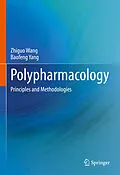There is a growing interest in unmet needs for the development of a new discipline in drug discovery and in university education on Polypharmacology. However, there has not been a book with the comprehensive compilation of basic knowledge and advanced methodology on Polypharmacology. This book aims to meet the needs of making Polypharmacology a new sub-discipline of Pharmacology, not only being a hot area of pharmacological research and education but also a new paradigm for drug discovery. It contains the contents covering the entire scope of Polypharmacology including systemic in-depth exposition of basic knowledge, novel concepts, innovative technologies, and translational and clinical applications by showcasing state-of-the-art strategies and step-by-step instructions of cutting-edge methods. The contents of Polypharmacology targets broad readerships including scientists in pharmacology research and drug development, and university teachers and graduates in medical school or schoolof pharmacy.
- Rich in illustrations and tables to showcase readers for better understanding the concepts and technologies related to Polypharmacology;
- Provides comprehensive, systemic, holistic, and explicit explanations and discussion of the fundamental knowledge, background information, conceptual evolution, and updated methodology, as well as in-depth mechanisms behind the knowledge and methodology of Polypharmacology;
- Main emphasis on rationally designed Polypharmacology or "multi-target, single-drug (MTD)" pharmacology, which represents the major future direction of Polypharmacology and Pharmacology;
- Describes the clinical applications of Polypharmacology to various human diseases in the clinical and preclinical settings;
- Contains a wide collection of the state-of-the-art Polypharmacology technologies applicable to the designed MTD discovery and the step-by-step descriptions of drug discovery process applying Polypharmacology principles and methodologies.
Autorentext
Inhalt
Tentative Table of Contents
PART I. Polypharmacology as a New Branch of Pharmacology: Concept and Principles
Chapter 1. Basics of Polypharmacology
Introduce the basic concept and knowledge of polypharmacology, including the definition, principles, historical account, scope, branches, roles and responsibilities, and advantages and disadvantages of polypharmacology in separate subsections. Particular emphasis and explanations will be given to "Multitarget drugs", and to the distinction among the concepts of Polypharmacology, designed Polypharmacology (multitarget drugs) and drug promiscuity (unintended Polypharmacology leading to drug toxicity).
Chapter 2. Polypharmacology in Clinical Applications: Multitarget Multidrug-combination (MTMD-C)
Describe the current status of applications of MTMD-C polypharmacology to various pathological entities in the clinical setting as well as in the preclinical situations. Illustrate the properties and strength of MTMD-C polypharmacology relative to the "Single-target, Single-drug" therapy and explicate the mechanisms of actions of MTMD-C.
Chapter 3. Polypharmacology in Clinical Applications: Multitarget Multidrug-single-formulation (MTMD-SF)
Present the updated information on the use of MTMD-SF polypharmacology in the treatment of various diseases in patients, as compared to "Single-target, Single-drug" and MTMD-C therapies, their modes of actions, pharmacokinetics, efficacies and underlying mechanisms.
Chapter 4. Polypharmacology in Clinical Applications: Multitarget Single-drug (MTSD)
Provide examples of MTSD polypharmacology in the treatment of various diseases in patients. Highlight its superior advantages and strengths in the therapeutic efficacy and safety profiles over other forms of pharmacological and polypharmacological therapies.
Chapter 5. Polypharmacology in Drug Discovery: Designed Epigenetic MTSD and Small-molecule MTSD
Describe the role of Polypharmacology in new drug discovery with focuses the rationally designed epigenetic MTSD and small-molecule MTSD, along with an introduction to natural product MTSD.
Chapter 6. Anti-cancer Polypharmacology
Introduce the use of Polypharmacology of different types (MTMD-C, MTMD-SF and MTSD) in the therapy of various types of cancer (lung cancer, breast cancer, leukemia, etc.) with real examples.
Chapter 7. Cardiovascular Polypharmacology
Introduce the use of Polypharmacology of different types (MTMD-C, MTMD-SF and MTSD) in the treatment of cardiovascular disease (hypertension, coronary artery disease, arrhythmias, heart failure, ischemic stroke) with real examples.
Chapter 8. Neuronal Polypharmacology
Introduce the use of Polypharmacology of different types (MTMD-C, MTMD-SF and MTSD) in the treatment of neuronal disease (Alzheimer's disease, Parkinson disease, epilepsy, etc.) with real examples.
Chapter 9. Pulmonary Polypharmacology
Introduce the use of Polypharmacology of different types (MTMD-C, MTMD-SF and MTSD) in the treatment of lung disease (chronic obstructive pulmonary disease, tuberculosis, cystic fibrosis, etc.) with real examples.Chapter 10. Polypharmacology of Metabolic Disease
Introduce the use of Polypharmacology of different types (MTMD-C, MTMD-SF and MTSD) in the treatment of metabolic disorders (diabetes, obesity, etc.) with real examples.Chapter 11. Polypharmacology of Infectious Disease
Introduce the use of Polypharmacology of different types (MTMD-C, MTMD-SF and MTSD) in the treatment of infectious disease (caused by bacteria, virus, parasite, etc.) with real examples.
Chapter 12. Polypharmacology of Inflammation
Introduce the use of Polypharmacology of different types (MTMD-C, MTMD-SF and MTSD) in the treatment of inflammation with real examples.
Chapter 13. Anti-psychotics Polypharmacology
Introduce the use of Polypharmacology of different types (MTMD-C, MTMD-SF and MTSD) in the treatment of various psychotic disorders (Schizophrenia, etc.) with real examples.
Chapter 14. Anti-aging Polypharmacology
Introduce the use of Polypharmacology of different types (MTMD-C, MTMD-SF and MTSD), which aids to combat age-dependent physiological decline and the associated diseases with real examples.
Chapter 15. Polypharmacology in Drug Repurposing
Introduce the use of Polypharmacology in drug repurposing (a highly efficient, time saving, low-cost and minimum risk of failure strategy and process of identifying new therapeutic uses for old/existing/available drugs).
Chapter 16. Polypharmacology and Unintended Drug Promiscuity
Introduce the use of Polypharmacology in unintended drug promiscuity of old/existing/available drugs or lack of desired target specificity that can cause side-effects and toxicity in the clinical applications of the drugs.
Chapter 17. Polypharmacology Pharmacokinetics
Introduce the complex process of…
